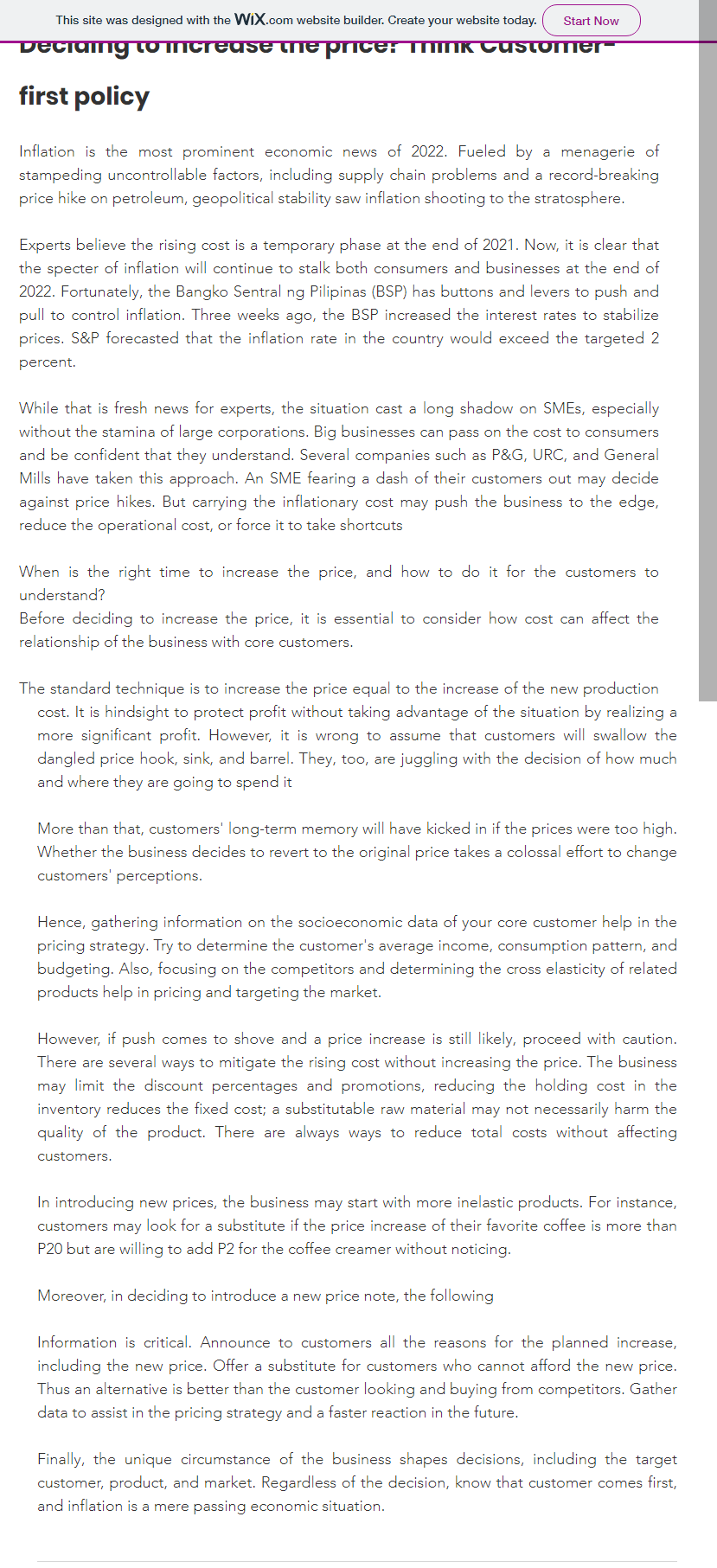Deciding to increase the price? Think Customer-first policy 1. Caution was the advice given in the article before increasing-price during inflation. Why? 2. Enumerate the techniques identified to reduce cost and thus avoid price increases during periods of inflation. What do you think is the most convenient? Why? 3. Among the steps to take before increasing-price which is the most difficult? Why?
Deciding to increase the price? Think Customer-first policy 1. Caution was the advice given in the article before increasing-price during inflation. Why? 2. Enumerate the techniques identified to reduce cost and thus avoid price increases during periods of inflation. What do you think is the most convenient? Why? 3. Among the steps to take before increasing-price which is the most difficult? Why?
Chapter14: Macroeconomic Policy: Tradeoffs, Expectations, Credibility, And Sources Of Business Cycles
Section: Chapter Questions
Problem 19E
Related questions
Question
100%
Deciding to increase the
1. Caution was the advice given in the article before increasing-price during inflation. Why?
2. Enumerate the techniques identified to reduce cost and thus avoid price increases during periods of inflation. What do you think is the most convenient? Why?
3. Among the steps to take before increasing-price which is the most difficult? Why?

Transcribed Image Text:This site was designed with the WIX.com website builder. Create your website today.
Start Now
Deciang to increase the price: Think Customer-
first policy
Inflation is the most prominent economic news of 2022. Fueled by a menagerie of
stampeding uncontrollable factors, including supply chain problems and a record-breaking
price hike on petroleum, geopolitical stability saw inflation shooting to the stratosphere.
Experts believe the rising cost is a temporary phase at the end of 2021. Now, it is clear that
the specter of inflation will continue to stalk both consumers and businesses at the end of
2022. Fortunately, the Bangko Sentral ng Pilipinas (BSP) has buttons and levers to push and
pull to control inflation. Three weeks ago, the BSP increased the interest rates to stabilize
prices. S&P forecasted that the inflation rate in the country would exceed the targeted 2
percent.
While that is fresh news for experts, the situation cast a long shadow on SMES, especially
without the stamina of large corporations. Big businesses can pass on the cost to consumers
and be confident that they understand. Several companies such as P&G, URC, and General
Mills have taken this approach. An SME fearing a dash of their customers out may decide
against price hikes. But carrying the inflationary cost may push the business to the edge,
reduce the operational cost, or force it to take shortcuts
When is the right time to increase the price, and how to do it for the customers to
understand?
Before deciding to increase the price, it is essential to consider how cost can affect the
relationship of the business with core customers.
The standard technique is to increase the price equal to the increase of the new production
cost. It is hindsight to protect profit without taking advantage of the situation by realizing a
more significant profit. However, it is wrong to assume that customers will swallow the
dangled price hook, sink, and barrel. They, too, are juggling with the decision of how much
and where they are going to spend it
More than that, customers' long-term memory will have kicked in if the prices were too high.
Whether the business decides to revert to the original price takes a colossal effort to change
customers' perceptions.
Hence, gathering information on the socioeconomic data of your core customer help in the
pricing strategy. Try to determine the customer's average income, consumption pattern, and
budgeting. Also, focusing on the competitors and determining the cross elasticity of related
products help in pricing and targeting the market.
However, if push comes to shove and a price increase is still likely, proceed with caution.
There are several ways to mitigate the rising cost without increasing the price. The business
may limit the discount percentages and promotions, reducing the holding cost in the
inventory reduces the fixed cost; a substitutable raw material may not necessarily harm the
quality of the product. There are always ways to reduce total costs without affecting
customers.
In introducing new prices, the business may start with more inelastic products. For instance,
customers may look for a substitute if the price increase of their favorite coffee is more than
P20 but are willing to add P2 for the coffee creamer without noticing.
Moreover, in deciding to introduce a new price note, the following
Information is critical. Announce to customers all the reasons for the planned increase,
including the new price. Offer a substitute for customers who cannot afford the new price.
Thus an alternative is better than the customer looking and buying from competitors. Gather
data to assist in the pricing strategy and a faster reaction in the future.
Finally, the unique circumstance of the business shapes decisions, including the target
customer, product, and market. Regardless of the decision, know that customer comes first,
and inflation is a mere passing economic situation.
Expert Solution
This question has been solved!
Explore an expertly crafted, step-by-step solution for a thorough understanding of key concepts.
Step by step
Solved in 2 steps

Knowledge Booster
Learn more about
Need a deep-dive on the concept behind this application? Look no further. Learn more about this topic, economics and related others by exploring similar questions and additional content below.Recommended textbooks for you



Economics (MindTap Course List)
Economics
ISBN:
9781337617383
Author:
Roger A. Arnold
Publisher:
Cengage Learning



Economics (MindTap Course List)
Economics
ISBN:
9781337617383
Author:
Roger A. Arnold
Publisher:
Cengage Learning

Exploring Economics
Economics
ISBN:
9781544336329
Author:
Robert L. Sexton
Publisher:
SAGE Publications, Inc